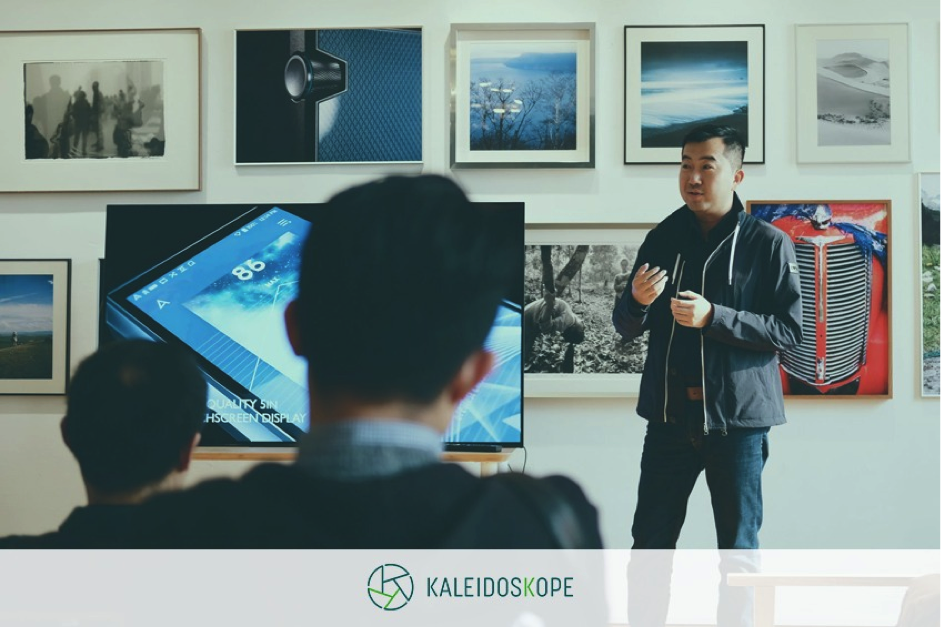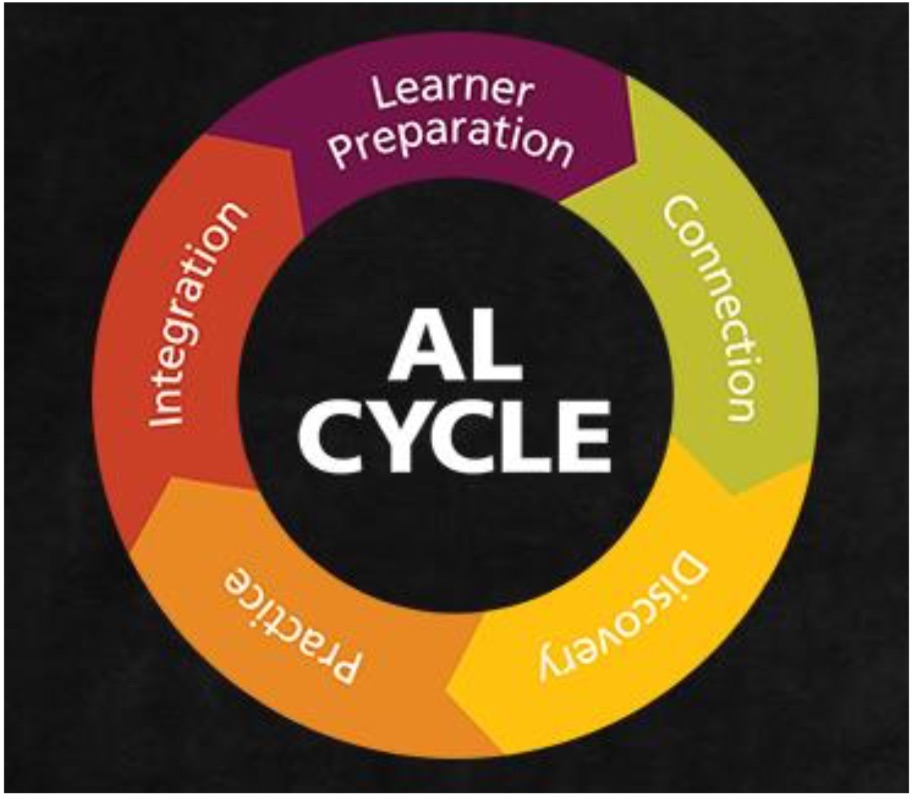Accelerative Learning – A Better Return on Training Investment (Part 3)

In Parts 1 and 2, we looked at the different types of learning story, introduced the concept of Accelerative Learning, explored the history of AL, how it is defined and the key principles for designing an AL program. In Part 3, we look at the AL cycle, how AL shows up in the classroom and the delivery approach, content design and benefits of an AL program.
The Accelerative Learning Cycle
When designing and facilitating an AL program, the AL cycle provides a broad but flexible template that helps ensure that all the principles of AL are met. The Accelerative Learning Cycle consists of the following five phases (Kinnard 2007):
- Learner Preparation Phase:
This involves prework designed to engage the learners minds and hearts before they actually arrive at the session. It prepares the learners for what is to come and makes it real.
- Connection Phase:
This involves consciously designing the program to allows participants to connect with the content at many different levels: intellectual, emotional and at times physically. It is the phase where the facilitator makes the most “boring” of subjects come to life.
- Creative Presentation Phase:
In this phase new material is presented, or learners are allowed to discover and develop new information in interactive, creative and memorable ways using mixed media and different structured learning methods.
- Activation Phase:
Here, learners begin to use the new information in a controlled and structured way using games and small group or whole group activities that are fun and meaningful. At this point, the facilitator is handing off the baton as learners’ competency increases.
- Integration Phase:
This phase brings the session to a close. It allows learners to transfer the learning to their lives through personal and group reflection and feedback and the development of ongoing learning commitments.
How does AL show up in the classroom?
Classroom environment:
Creating the right classroom environment is crucial to an effective AL training session. The classroom setting needs to be colourful, comfortable and naturally stimulating. It needs to feel like fun; designed to help the participants relax and eliminate whatever uncertainty, stress or learning barriers they may come in with. The setting needs to be collaborative and mutually supportive.
This can be created by careful room set up, using cabaret style layout, choosing a room with natural light, using colourful table throw overs, providing table toys, using bright image-based content and peripheral posters and the skilful use of music.
Delivery approach:
The delivery approach needs to be learner-centred as opposed to teacher-centred. The AL facilitator needs to be skilled in:
- Using open-ended questions to create and hold discussion
- Active listening to ensure all participants are engaged and heard
- Attending to their own nonverbal communication to energise the session and support the learning process
- Observing the participants, inferring what they are up to and taking action to keep the learning on track.
Content and material:
Content needs to be designed to appeal to all three of the learning modalities; audio, visual and kinaesthetic. This requires a skilful blend of speaking, written content, posters and images, video, music, and activities involving group discussion, games and physical engagement. Time also needs to be built into the session for contemplation and reflection to allow the learning to be processed and assimilated by the participants.
What are the benefits of Accelerative Learning?
AL is effective because it actively engages learners in driving their own learning. People leave an AL training session having had fun, feeling engaged and excited and ready to implement what they have learned in the workplace. It is a total system for speeding and enhancing both the design and learning processes that provides a consistently high level of return on any training investment.
In the words of Gary Schornack, “Our challenge as instructors is to help the student learn more faster, easier, with greater retention. Accelerated learning is the method, and it is fun for both the instructor and student. We can help our students become world-class experts and gurus in our field if we are willing to change our thinking on how our students learn.”(Schornack 1996)
If you’d like to apply Accelerative Learning to training events at your own organisation, talk to us at Kaleidoskope, today.
Sources and References:
Bathla, Som (2018). “The Magic of Accelerated Learning: Discover Strategies for Effective Learning, Improved Memorisation, Sharpened Focus and Become an Expert in Any Skill You Want”
Conners, K (2018). “Accelerated Learning: Advanced Strategies for Improved Memorisation, Effective Listening and Increased Productivity”
Kinnard, Karen (2007). “The Accelerated Learning Cycle: Are You Ready to Learn? Am I Ready to Lead?“
Labiosa, Libyan; Atkisson, Alan (1996). “Accelerated Learning – The value of playing games, singing songs, listening to stories and how learning is improved by the power of suggestion”
Labiosa, Libyan; Randig, Sinéad; Cassone, Philip (2018). “The Accelerative Learning Road Less Travelled”
McKeon, Kevin J. (1995). “What is this Thing Called Accelerated Leaming?” Training and Development Journal, Vol. 49, No. 6.
Nitsche, Pearl (2017). “Nonverbal Classroom Management – Group Strategies that Work”
Schornack, Gary (1996). “Accelerated Learning Techniques for Adults – An Instructional Design Concept for the Next Decade”
Smith, Alastair (2016). “Accelerated Learning in Practice”
Wilkens, Jonathan (2017). “Accelerated Learning: Accelerated Learning Techniques, Memory Techniques, Improve Your Memory, Learn More in Less”
Zemke, Ron (1995). “Accelerated Leaming: madness with a method,” Training and Development Journal, Vol. 32, No. l 0
Additional Information:
(CAL 2019). The Center for Accelerated Learning – Click here to learn more
(ICAL 2019). International Centre for Accelerative Learning (ICAL) – Click here to learn more
(Administrate 2018). Administrate Group – Visit blog on how the World spent 359B on trainings
(Watson 2013). CCW Consulting LLC – Click here to learn more
Leadership Training
- Business Storytelling – A Critical Skill For Great Leadership
- Want to make history as a leader? Try studying these great leaders from history
- Solution Focused Leadership Coaching
- Leading the Way for Leaders: How Your Leadership Can Continue to Evolve
- How to Manage a High-Performance Team Made Up of Different Personalities
- Have You Mastered the 4 Leadership Fundamentals?
- Do You Practise Adaptive Leadership? Your Organisation Needs You To
- Why A Good Leader Needs To Understand Business Agility
- 20 Qualities of a Good Leader in Times of Change (A Checklist)
Corporate Training
- Why is your training, boring?
- Learning Initiatives at Work CAN Lead to A Great ROI. Here’s How
- Corporate Training Doesn’t Seem to Be Working? You Need an HPLJ Approach!
Facilitation Training
- Facilitate a High Impact Training Course with Accelerated Learning
- Accelerative Learning – A Better Return on Training Investment (Part 1)
- Accelerative Learning – A Better Return on Training Investment (Part 2)
- Accelerative Learning – A Better Return on Training Investment (Part 3)
Virtual Learning
Start Your High-Performance Learning Journey
WITH KALEIDOSKOPE NOW!
In Part 1, we looked at the different types of learning story and introduced the concept of Accelerative Learning. In this post we explore the history of Accelerative Learning, how it is defined and the key principles of designing an AL program.
Accelerative Learning – A Better Return on Training Investment (Part 2)

In Part 1, we looked at the different types of learning story and introduced the concept of Accelerative Learning. In this post we explore the history of Accelerative Learning, how it is defined and the key principles of designing an AL program.
Where did Accelerative Learning come from?
The father of AL is the Bulgarian psychiatrist Dr. Georgi Lozanov. Dr Lazanov’s initial work in the 1960s was called “Suggestopedia”. He discovered that creating a positive and supportive learning environment that puts people into a state of “relaxed alertness” had a significant impact on learning outcomes (Smith 2006).
Dr. Lazonov’s work was built upon by Dr. Evelyn Gateva with Curriculum and Instructional Design; Libyan Labiosa Cassone who coined the term Accelerative Learning; Professor Stephen Krashen with Language Acquisition; Dr. Roger Sperry’s brain research (awarded the Nobel Prize in Physiology and Medicine in 1981); Professor Howard Gardner with Multiple Intelligences; Professor Marian Diamond and the Enriched Learning Environment and Professor James Asher with Total Physical Response.
Other contributions over the years have included Tony Buzan’s work on memory, Brandler and Grinder’s work on Neuro-Linguistic Programming, Czikszentmihalyi’s work on human fulfilment and flow among many others.
It is a long lineage of research bringing AL to the powerful multi-method, multimedia learning technique that it is today.
How is Accelerative Learning defined?
Accelerative Learning, also known as Accelerated Learning in the corporate world, is defined as “a method of instruction that provides an atmosphere where students are able to absorb and retain concepts by overcoming traditional barriers of learning” (McKeon 1995). It is a combination of neuroscience, cognitive psychology and instructional design which involves training facilitators, creating content and developing material (Labiosa 1996).
What are the principles of Accelerative Learning?
So how does it work? AL training is designed and delivered around a number of key principles which can be summarised as follows (CAL 2019):
1. Learning involves the whole of the body and mind
The learning approach is designed to engage the learner’s body, senses, creativity and emotions and not just the “head” centred rational and verbal consciousness.
2. Learning is created and not consumed
The learner actively creates knowledge as opposed to absorbing it. This is not a passive process of sitting and listening but an active process of integrating new knowledge and skills into the learners’existing structure of self.
3. Collaboration facilitates learning
Research indicates that creating competition between learners slows learning down whereas creating collaboration speeds it up. People often learn more by interacting with peers than by any other means. Creating collaboration is a central tenet of any AL program.
4. Learning takes place on many different levels simultaneously
The brain does not work sequentially, in a linear way but is a parallel processor which thrives when challenged to do many things at once. AL engages people on many different levels simultaneously; using all the receptors, senses and pathway it can to bring the learning into the person’s full brain and body system.
5. Learning comes from doing and feedback
Information learned in isolation, without a frame of reference, is quickly forgotten. By ensuring Immediate practical application of knowledge, or learning by doing, AL provides the brain with the context and frame of reference for long term retention. AL also provides time for immersion, feedback, reflection and re-immersion to lock learning in.
6. Positive emotions greatly improve learning
Learning that is associated with negative emotional states such as stress, frustration, discomfort or boredom is quickly left behind. By actively creating feelings of relaxation, fun and engagement, AL creates a higher quality of learning and retention.
7. The image brain absorbs information instantly and automatically
The human nervous system is a far more powerful image processor than it is a word processor. Images are easier to process, understand and retain than verbal abstractions. By translating verbal content into images of all kinds, AL makes training content faster to learn and easier to remember.
In Part 3, we look at the AL Cycle for success, how AL shows up in the classroom and the delivery approach, content and benefits of an AL program. If you have questions about anything you’ve read so far, ask us here.
Sources and References:
Bathla, Som (2018). “The Magic of Accelerated Learning: Discover Strategies for Effective Learning, Improved Memorisation, Sharpened Focus and Become an Expert in Any Skill You Want”
Conners, K (2018). “Accelerated Learning: Advanced Strategies for Improved Memorisation, Effective Listening and Increased Productivity”
Kinnard, Karen (2007). “The Accelerated Learning Cycle: Are You Ready to Learn? Am I Ready to Lead?“
Schornack, Gary (1996). “Accelerated Learning Techniques for Adults – An Instructional Design Concept for the Next Decade”
Smith, Alastair (2016). “Accelerated Learning in Practice”
Wilkens, Jonathan (2017). “Accelerated Learning: Accelerated Learning Techniques, Memory Techniques, Improve Your Memory, Learn More in Less”
Zemke, Ron (1995). “Accelerated Leaming: madness with a method,” Training and Development Journal, Vol. 32, No. l 0
Additional Information:
(CAL 2019). The Center for Accelerated Learning
(ICAL 2019). International Centre for Accelerative Learning (ICAL)
(Administrate 2018). Administrate Group – Click here to learn how the world spent 359B on trainings
(Watson 2013). CCW Consulting LLC –Click here to visit
Leadership Training
- Business Storytelling – A Critical Skill For Great Leadership
- Want to make history as a leader? Try studying these great leaders from history
- Solution Focused Leadership Coaching
- Leading the Way for Leaders: How Your Leadership Can Continue to Evolve
- How to Manage a High-Performance Team Made Up of Different Personalities
- Have You Mastered the 4 Leadership Fundamentals?
- Do You Practise Adaptive Leadership? Your Organisation Needs You To
- Why A Good Leader Needs To Understand Business Agility
- 20 Qualities of a Good Leader in Times of Change (A Checklist)
Corporate Training
- Why is your training, boring?
- Learning Initiatives at Work CAN Lead to A Great ROI. Here’s How
- Corporate Training Doesn’t Seem to Be Working? You Need an HPLJ Approach!
Facilitation Training
- Facilitate a High Impact Training Course with Accelerated Learning
- Accelerative Learning – A Better Return on Training Investment (Part 1)
- Accelerative Learning – A Better Return on Training Investment (Part 2)
- Accelerative Learning – A Better Return on Training Investment (Part 3)
Virtual Learning
Start Your High-Performance Learning Journey
WITH KALEIDOSKOPE NOW!
This blog post is the first of three posts on Accelerative Learning (AL) theory. In Part 1, we look at the different types of learning story and introduce the concept of Accelerative Learning.
Accelerative Learning – A Better Return on Training Investment (Part 1)

This blog post is the first of three posts on Accelerative Learning (AL) theory. In Part 1, we look at the different types of learning story and introduce the concept of Accelerative Learning.
The learning story (Part 1)
Picture the scene. A presenter is at the front of the room, 40 minutes into a session about ethical compliance obligations, literally talking to his 35th PowerPoint slide. There are a few people at the front fighting to stay awake, most are on their phone or tablet and one or two at the back are literally nodding off. The presenter speeds up in a bid to get it over and done with. At the end of the session, there is muted applause and a collective rush for the door. The company can tick the box on ethics training – but did anyone really learn anything? A day or two later and most of the participants probably won’t even remember having been in the room and will determine to avoid the next session like the plague.
Unfortunately, this scene is playing out in corporate meeting rooms every day all over the world and it begs the question, what’s the point? If people are leaving training sessions, going back to work and continuing to do the same things in the same way as they did before they went in, then it really is just a waste of time and money. It is estimated that businesses worldwide spend $350B each year on training (Administrate 2018), not including the cost of participant hours. What percentage of that spend is really having a material impact?
It doesn’t have to be like this. There are tried and tested learning approaches that can and do increase learning effectiveness, ensuring a significant return on a company’s investment in training. One particularly powerful, well researched and documented approach is Accelerative Learning (AL).
What is Accelerative Learning (AL)?
Accelerative Learning (AL) has been described as the most advanced teaching and learning method in use today (CAL 2019). It is a powerful approach based on over 50 years of brain research, designed to enhances both the training design and the learning process. When applied correctly, it has been proven to significantly increase learning effectiveness whilst saving time and money.
Based on the way that human beings naturally learn, AL taps into our innate potential for learning in a way that traditional learning methods cannot. It does this by fully involving the participant in their own learning experience using physical activity, creativity, colour, images, music and the whole training environment.
AL is described as activity-based and learner-driven (ABLeD), where learners discover and create their own knowledge through meaningful activities and authentic experience. The trainer becomes “the guide on the side” as opposed to “the sage on the stage” (CWW 2013), facilitating the learning process and delivering content only to supplement the learners’ own process of discovery and creation.
The learning story (Part 2)
Picture the scene with the application of AL. Three groups of participants have been busily discussing a scenario where a company employee is facing an ethical dilemma that looks like it could be in breach of the law. They’ve studied the legislation, figured out the relevant clauses, prepared their feedback and are about to present. The brief requires the first group to feedback with a poster and no words; the second group has to create a song; and the third group has to act it out. The room is tense with excited anticipation…
They leave the room not only having actively studied the content but also having seen, heard and felt it through the media of three different learning modalities. In the process, they have built relationships, broken down barriers, had a lot of fun and are ready to take what they have learned back to the workplace and sign up for the next session.
In Part 2, we explore the history of Accelerative Learning, how it is defined and the key principles for designing an AL program. If youhave questions about anything you’ve read so far, ask us here.
Sources and References:
Bathla, Som (2018). “The Magic of Accelerated Learning: Discover Strategies for Effective Learning, Improved Memorisation, Sharpened Focus and Become an Expert in Any Skill You Want”
Conners, K (2018). “Accelerated Learning: Advanced Strategies for Improved Memorisation, Effective Listening and Increased Productivity”
Kinnard, Karen (2007). “The Accelerated Learning Cycle: Are You Ready to Learn? Am I Ready to Lead?“
Labiosa, Libyan; Atkisson, Alan (1996). “Accelerated Learning – The value of playing games, singing songs, listening to stories and how learning is improved by the power of suggestion”
Labiosa, Libyan; Randig, Sinéad; Cassone, Philip (2018). “The Accelerative Learning Road Less Travelled”
McKeon, Kevin J. (1995). “What is this Thing Called Accelerated Leaming?” Training and Development Journal, Vol. 49, No. 6.
Nitsche, Pearl (2017). “Nonverbal Classroom Management – Group Strategies that Work”
Schornack, Gary (1996). “Accelerated Learning Techniques for Adults – An Instructional Design Concept for the Next Decade”
Smith, Alastair (2016). “Accelerated Learning in Practice”
Wilkens, Jonathan (2017). “Accelerated Learning: Accelerated Learning Techniques, Memory Techniques, Improve Your Memory, Learn More in Less”
Zemke, Ron (1995). “Accelerated Leaming: madness with a method,” Training and Development Journal, Vol. 32, No. l 0
Additional Information:
(CAL 2019). The Center for Accelerated Learning – blog for center for accelerated learning
(ICAL 2019). International Centre for Accelerative Learning (ICAL) – visit for more information
(Administrate 2018). Administrate Group – Click here to learn How the World spent 359 Billion on trainings
(Watson 2013). CCW Consulting LLC – learn more about consulting
Leadership Training
- Business Storytelling – A Critical Skill For Great Leadership
- Want to make history as a leader? Try studying these great leaders from history
- Solution Focused Leadership Coaching
- Leading the Way for Leaders: How Your Leadership Can Continue to Evolve
- How to Manage a High-Performance Team Made Up of Different Personalities
- Have You Mastered the 4 Leadership Fundamentals?
- Do You Practise Adaptive Leadership? Your Organisation Needs You To
- Why A Good Leader Needs To Understand Business Agility
- 20 Qualities of a Good Leader in Times of Change (A Checklist)
Corporate Training
- Why is your training, boring?
- Learning Initiatives at Work CAN Lead to A Great ROI. Here’s How
- Corporate Training Doesn’t Seem to Be Working? You Need an HPLJ Approach!
Facilitation Training
- Facilitate a High Impact Training Course with Accelerated Learning
- Accelerative Learning – A Better Return on Training Investment (Part 1)
- Accelerative Learning – A Better Return on Training Investment (Part 2)
- Accelerative Learning – A Better Return on Training Investment (Part 3)
Virtual Learning
Start Your High-Performance Learning Journey
WITH KALEIDOSKOPE NOW!
Find out what makes training boring and factors affecting training impact and efficiency. Click the link the link to know more.
Impact and Efficiency: Why is Your Training, Boring?

Let’s face it: the battle for people’s attention is an uphill one. It can be tough to get an audience to listen, let alone learn. No matter how hard you try, sometimes, it just seems impossible to get trainees to not just truly learn something, but to be eager to put what they’ve learned into practice.
To find out what makes training
Get the most out of training events with David Turberfield.
Look out for these liabilities that can suck the life out of your training.
The number of countless, seemingly endless training sessions conducted across industries makes it relatively easy to determine exactly what contributes to their boring-ness.
Some of the most common denominators boring training events
- Reading from slides. Simply reading text on a slide instead of explaining it tends to cause your audience to stop listening and their minds to shut down. After all, they can just as easily read it for themselves (and more often than not, much faster than you can read it aloud).
- Too much text on slides. Unsurprisingly, text-heavy visuals are heavy on the eyes, which is no help at all in keeping your listeners awake, especially if your presentation happens to be scheduled in the afternoon.
- Spending too much time preparing slides, and not enough time getting ready for the actual presentation or training activity, itself. Many trainers make the mistake of equating slide preparation with preparation for the act of presenting.
- Forgetting about the trainees.
Still other trainers get so caught up in preparing what the trainees need to know, that they overlook the need to put themselves in the trainees’ shoes. As a result, they forget to ask questions such as, “Would the audience find this interesting?”
- Speaking longer than 10 minutes. Studies suggest that people being presented to (as is usually the case during training events) really only pay attention for about 10 minutes, after which their concentration and engagement tend to wane.
It’s no accident that the first three factors involve the use of slides; indeed, some industry experts recommend doing away with slides altogether during training. Still other experts lay the blame not on the slides themselves but on the way the slides are used, that is to say, using them as cue cards instead of aide-
But pretty much anyone who’s ever written about the pitfalls of keeping training and presentations engaging agrees that the audience’s attention span is the most important factor for consideration—arguably making No. 5 the most probable cause of boring training sessions.
Get the most out of training events with David Turberfield.
Leverage these learning hacks to breathe new life into your training.
Now that we’ve identified the causes, we can now look for the cures. If the way you use slides during training is the problem, better preparation is the solution—which means knowing what you’re teaching inside and out so as not to need slides.
If you must have the information you wish to impart on hand, keep them in a few, succinct bullet points in the space for notes on each slide, instead of on the slide itself. This way, they won’t be visible to your trainees.
Feel iffy about going in without slides? Try using the slides more for visual aids rather than text. Slides are ideal for showing tables, graphs
But as the challenge of your listeners’ “10-minute limit” is paramount, here are some particular tips to help you overcome it:
- Connect with your audience. If eye contact isn’t your thing, try looking just above their heads to give the impression that you are looking at them. If audience size permits, call people by name or choose people to participate in demonstrations. Try using open questions to create discussion and have your attendees speaking, being heard and listening to each other.
- Learning by design. Design your material to be less
slide based and more conversational. Convert the material into scenarios that can be used forgroup based discussion and feedback, have the participants doing the work. Have them feedback in innovative in fun ways thatgets them thinking and their colleagues really paying attention.
- Once upon a time… Storytelling has always been an effective and engaging way to hold people’s attention and impart information. Use stories to illustrate or demonstrate a point, whether they’re taken from real life or just made up.
- Break it up to wake them up. Once your presentation hits the 10-minute mark, let your audience take a break. This doesn’t have to be a literal bathroom or coffee break; it could also mean a video after 10 minutes of slides, for instance, an exercise, discussion or quick Q&A session.
- Not more than four. Studies also suggest that people can only process and remember four new pieces of information at a time, so there’s really no point in cramming in so much info in one go. Try to plan the training event in such a way that only four or
less lessons are taught at a time.
- Ditch the script. While the essential preparation and rehearsal for a training session may involve some
memorisation , it helps immensely to not make it sound like you memorized a script. To this end, ad-libbing helps make things sound a lot more natural and more likely to hold your audience’s interest.
The tips are just a tiny sample of what you can do you to make sure everyone at your
Get the most out of training events with David Turberfield.
ICF Associate Certified Coach and NVW Certified Integral Coach, David Turberfield has 25 years of experience showing trainers and facilitators how to hold an audience’s interest, and to make sure they actually learn.
As an approved Accelerative Learning Facilitator who has led High Impact Facilitation Train the Trainer courses, David has conducted workshops such as
- Shell China Exploration & Production Company (
SCEPCO ) Safety Summit, Chengdu, China - Bayer Annual HSE Workshop, HCMC, Vietnam
- Samsung C&T CEO Forum, Seoul, Korea
- 3M Annual APAC EHS Leadership Workshop, Singapore
- AES APAC Leadership Workshop, Masinloc, Philippines
- GDF Thailand Leadership Workshop, Chonburi, Thailand
- Micron APAC Leadership workshop, Taichung, Taiwan
David is the lead facilitator for the Accelerated Learning (AL) course at
Leadership Training
- Business Storytelling – A Critical Skill For Great Leadership
- Want to make history as a leader? Try studying these great leaders from history
- Solution Focused Leadership Coaching
- Leading the Way for Leaders: How Your Leadership Can Continue to Evolve
- How to Manage a High-Performance Team Made Up of Different Personalities
- Have You Mastered the 4 Leadership Fundamentals?
- Do You Practise Adaptive Leadership? Your Organisation Needs You To
- Why A Good Leader Needs To Understand Business Agility
- 20 Qualities of a Good Leader in Times of Change (A Checklist)
Corporate Training
- Why is your training, boring?
- Learning Initiatives at Work CAN Lead to A Great ROI. Here’s How
- Corporate Training Doesn’t Seem to Be Working? You Need an HPLJ Approach!
Facilitation Training
- Facilitate a High Impact Training Course with Accelerated Learning
- Accelerative Learning – A Better Return on Training Investment (Part 1)
- Accelerative Learning – A Better Return on Training Investment (Part 2)
- Accelerative Learning – A Better Return on Training Investment (Part 3)
Virtual Learning
Start Your High-Performance Learning Journey
WITH KALEIDOSKOPE NOW!
Let’s take a look at what accelarated learning is, how it works, and how it can make a huge difference in your own facilitation training course. Learn more.
Facilitate a High Impact Training Course with Accelerated Learning

In Singapore, corporate leadership development is a necessity, but how engaged is your organisation with its learning journey, really? If you know what it’s like to sit through a training session wondering when in blazes it was going to end, read on.
Whether you’ve had to attend because your boss said so, or even if you had to be the one to do the actual training, regular, run-of-the-mill training can be a chore. Yes, even for the very people who have to get up there in front of a roomful of people, hoping against hope that their audience doesn’t fall asleep and actually learns something, this perception of training can be very real.
The good news is that “training as a chore syndrome” for both trainer and trainee can also be overcome. And that’s where Accelerated Learning or AL steps in.
Now, don’t get carried away by the “accelerated”, as this type of learning isn’t only about picking things up faster. AL in corporate learning initiatives is focused on high impact training where training session participants are excited by the learning process, and can’t wait to get out there and apply what they’ve learned.
Let’s take a look at what AL is, how it works, and how it can make a huge difference in your own organisation’s training programmes.
The Most Advanced Learning Approach
Neurology and learning experts recognise AL as the most advanced learning approach used in organisations today. With its focus on de-mechanising and re-humanising the learning process, AL provides a holistic experience that is highly engaging, motivating and effective. AL is based on the principle that people learn better when they participate in the learning process.
The end goals of an AL-facilitated training session include
- Guiding participants to learn from their experiences and from others in their workplace
- Teaching participants to apply the skills, concept and attitudes they’ve learned
- Creating a comfortable environment to allow high-engagement learning to take place
Studies show that applying AL to training courses results in maximised learning retention and efficiency, as well as a better return on investment.
How does Accelerated Learning work?
To enhance the learning experience, AL combines fun and seriousness in ways that produce the most positive results. As an entirely results-focused approach, AL isn’t “fun for fun’s sake”, nor is it stoic or inflexible.Training methods using the AL approach adjust to the subject matter and the learners themselves at a particular organisation.
The Accelerated Learning Cycle is made up of five distinct phases:

- Learner Preparation provides logistical information to prepare for participants.
- Connection creates a safe, positive learning environment that connects participants to the learning.
- Discovery presents new material to allow learners to discover and develop new information in creative, interactive and memorable ways.
- Practice is where learners begin to use the new material in controlled and structured activities, and the facilitator passes the baton to the learners as they demonstrate increasing mastery in creative and individualised ways.
- Integration or Mastery Demonstration is where learners use interactive methods to “teach back” what they have learned.
Development psychologist and professor Howard Gardner’s Multiple Intelligences (MI) theory is an Accelerated Learning model that focuses on how information is processed and used to solve problems. It allows a facilitator to adjust to needs of individual participants based the kinds of intelligence they have or learning methods they prefer.
Similar to MI is another AL model, the Audio, Visual, Kinesthetic (AVK) Learning Modalities, which focuses on the sensory channels whereby a person receives and stores information.
It ALL Depends On the Trainer
How much impact AL has on the training event depends on the drive and skill of the trainer. An AL facilitator needs to encourage involvement by showing a genuine interest in the participants, and make the participants feel free to comment and ask questions. The trainer has to constantly obtain their feedback about the training and be ready to respond to their needs.
There are four key skills for Accelerated Learning facilitation:
- Listening involves active listening, developing listening skills, and being aware of the barriers to effective learning.
- Questioning involves stimulating discussion and encouraging dialogue using questioning techniques in facilitation, and knowing which types of questions to ask.
- Attending involves eye contact, facial expression, body language and gestures, as well as paying close attention to the tone and pace of one’s voice and movement so as to hold the participants’ attention and maintain control of the session.
- Observing involves watching the body language of the participants and making inferences, as well as taking action based on these inferences to carry the learning forward.
It’s up to the trainer to create an optimal learning environment, which is possible by remembering that learners learn best when they are relaxed, and information is presented whilst involving their emotions in a positive way.
This, in turn, takes place when the facilitator’s presentation combines visual, auditory and physical elements that encourage the participants to use their learning and thinking skills to the full. These physical AL elements include the classroom set-up, which comprises the seating arrangement, tables, walls, floors and teaching materials.
The music you play during the training session is another AL element that can have a positive effect on the participants’ learning. It’s a good idea to prepare a selection of music for the start of the session, breaks, activities, reflection, celebration, and wrap-up.
At Kaleidoskope, we’re committed to working closely with you to support your training and facilitation programmes long after your training event. We’ll be checking in with you regularly with coaching and workshops, as our experience in corporate learning initiatives shows this kind of engagement is crucial to the continuing development of your event’s participants.
Our course facilitators have over 20 years of experience working with leading companies on transferring professional facilitation expertise to trainers and presenters. Their experience includes advanced facilitation skills, high impact training, and the facilitation of hands-on training programmes.
Professional coach, speaker and high impact facilitator, David Turberfield, has 25 years of training and facilitation experience primarily in Asia for some the world’s leading companies in various industries. As a certified Accelerative Learning Facilitator, David is the lead facilitator for our AL course.
Accelerate your in-house training events with Kaleidoskope. Talk to us today to find out how—becoming a better facilitator is just a click away.
Leadership Training
- Business Storytelling – A Critical Skill For Great Leadership
- Want to make history as a leader? Try studying these great leaders from history
- Solution Focused Leadership Coaching
- Leading the Way for Leaders: How Your Leadership Can Continue to Evolve
- How to Manage a High-Performance Team Made Up of Different Personalities
- Have You Mastered the 4 Leadership Fundamentals?
- Do You Practise Adaptive Leadership? Your Organisation Needs You To
- Why A Good Leader Needs To Understand Business Agility
- 20 Qualities of a Good Leader in Times of Change (A Checklist)
Corporate Training
- Why is your training, boring?
- Learning Initiatives at Work CAN Lead to A Great ROI. Here’s How
- Corporate Training Doesn’t Seem to Be Working? You Need an HPLJ Approach!
Facilitation Training
- Facilitate a High Impact Training Course with Accelerated Learning
- Accelerative Learning – A Better Return on Training Investment (Part 1)
- Accelerative Learning – A Better Return on Training Investment (Part 2)
- Accelerative Learning – A Better Return on Training Investment (Part 3)
Virtual Learning
Start Your High-Performance Learning Journey
WITH KALEIDOSKOPE NOW!
Start Your High-Performance Learning Journey
with Kaleidoskope NOW!
Call Us Or Message Us on Whatsapp
Or Fill Out the Form Below


